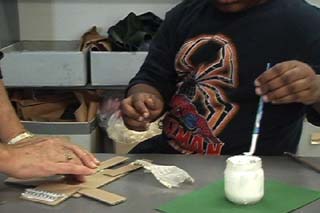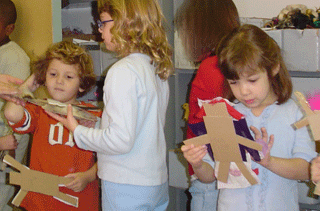



 |
 |
 |
 |
"Whether it's paint, or drawing, or clay, all of the materials lead to a kind of connection that can be very, very profoundly deep and personal. I think it's just a matter of trusting kids, which I do 100%, giving them good materials, asking them good questions. They will come forward with their own passions and their own interests, and they will express them in materials, and they will learn about the world that way and they'll communicate that way, and they will express themselves in very personal ways. I see it over and over." --Nancy Beal |
|
Nancy invites her students to arrive at a personal connection with their work. A key component of this approach is using appropriate motivating questions, and often including the words, "how can you?"
|
|
"My purpose is to tap into their personal imagery. There's such a deep, personal connection to this work, that's theirs and not mine. And that's why I believe that this is really of value to them, because they're following their own little hearts, their own interests, instead of following some sort of direction." "I use that word 'how' to get to that personal connection with the child's life. Asking 'how' invites any answer, it invites something personal. 'How can you make a friendly or a fierce animal?' 'How can you make a painting that shows something you like to do?'" "I try to ask stimulating questions that reach into their expressive center, into their hearts and minds." --The Art of Teaching Art to Children, page 14. |
Nancy nurtures many different developmental stages in one classroom.
|
 Nancy helps some children along as they move through their development, and others work on their own. movie clip [80 sec/ 8MB] Nancy helps some children along as they move through their development, and others work on their own. movie clip [80 sec/ 8MB] |
"There are many developmental stages going on in one room at the same time. You can't force somebody who's working at stacking things randomly to be at the same place as someone who's arranging them with a very thoughtful symmetry. Within a classroom, all the kids are working at their own level, working happily, and growing at their own rate. This leads, in the exploration of materials, to kids working in increasingly sophisticated ways." "No matter what their age, I try to give the children every chance to go through their artistic developmental stages on their own." --The Art of Teaching Art to Children, page 12. |
Nancy describes specifically what she sees in each child's work.
|
"How an adult responds to the child's artwork is extremely significant. It's important that a grown-up not project his or her own ideas onto the work. Many teachers ask the kids to explain what they're doing. I try not to do this because the work itself will tell me loud and clear if I look at it carefully. Adult responses succeed best when they're nonjudgmental and are as specific as possible." --The Art of Teaching Art to Children, pp.7-8 "I try to notice things to bring them to the child's awareness. The most important thing is not the beauty of the art but the child's incremental growth. That is what I remark about. For example, I might say, 'You cut each piece of fabric to the same size as the cardboard of your person.' Careful looking and mentioning what you see builds up the children's confidence, gives them a sense of accomplishment, and ultimately helps them to be good learners across the board." |
|
| Nancy encourages students to connect their art to their lives. |  |
"They're making the meaning." "That's it right there; that's the connection. And they can make these in the classroom, they can use them with block-building. All the dramatic play of this age can be served with these people and animals. Better than a doll given to them is one they make themselves." |